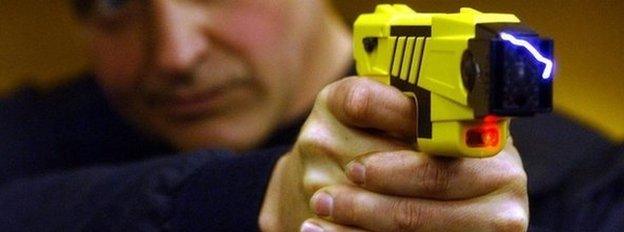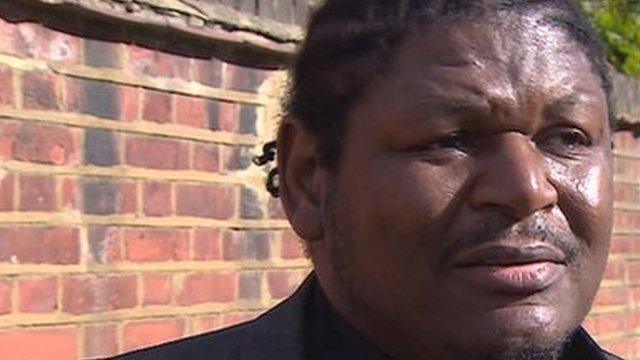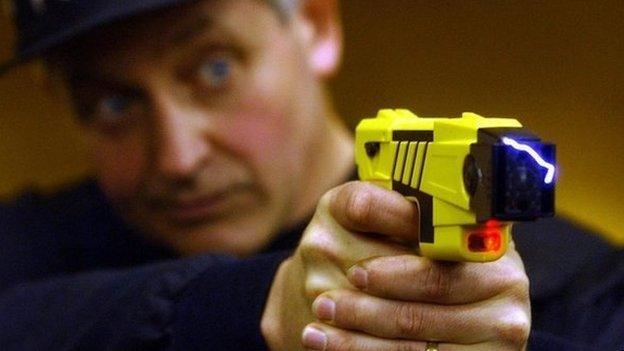Black people 'three times more likely' to be Tasered
- Published
Daniel Sylvester was Tasered by police as he drove home: ''The pain is unbelievable''
Black people are three times more likely than white people to be involved in Taser incidents, Home Office figures disclosed to the BBC suggest.
The numbers show the electric stun gun was drawn, aimed or fired 38,000 times in England and Wales over five years.
In more than 12% of cases Tasers were used against black people, who make up about 4% of the population.
Officers were accountable to the law each time their weapon was drawn, the National Police Chiefs Council said.
The figures, covering the years 2010 to 2015, were compiled by the Home Office from all 43 police forces in England and Wales following a Freedom of Information Act request to the Home Office.
The figures also show a rise in Taser incidents against children.
Tasers were used by police 38,135 times, though in most incidents - 80% last year - the weapons were not discharged.
The ethnicity of the person against whom the Taser was used was recorded on 36,038 occasions.
In 4,582 of those cases they involved a black person of African-Caribbean origin or of mixed white and African-Caribbean origin - representing 12.7%.
In contrast, proportionately fewer people of Asian descent were involved in Taser incidents.
Although it has been well documented that black people are more likely to be stopped and searched, arrested and sent to prison than those who are white, this is the first time figures have been produced showing that across England and Wales black people are more likely to have Tasers used against them.

Analysis

By BBC Freedom of Information specialist Martin Rosenbaum
The difference in how often ethnic groups encounter Taser use is dramatic.
For Asians the chance of involvement in a Taser incident in 2010-14 in England and Wales was only three in 10,000, whereas for white people it was six and for black people it was 18 in 10,000.
Some 12.7% of incidents in 2010-14 involved Black people, who constitute only 4.4% of the population. But only 4% involved Asians, who form 8.1% of the population.

This pattern is repeated in all age groups. Tasers are mainly used on men in their twenties and thirties, but the discrepancy is not caused by different ethnic age distributions.
It is also reflected across England and Wales, including those local forces with enough incidents to assess separately (West Midlands, West Yorkshire, Greater Manchester and the Metropolitan Police).
The ethnic discrepancy also occurs across the various levels of Taser deployment, from being drawn to fired.

Matilda MacAttram, from the campaign group Black Mental Health UK, said the statistics were "deeply disturbing" and pointed to emerging evidence that police were using Tasers against people with mental health problems, particularly those from African-Caribbean communities.
"There's an increasing amount of data, both anecdotal and also concrete, which show this supposedly "non-lethal" weapon is being used against people who are in a very vulnerable state.
"That's actually a violation of their human rights and it should not be happening," she said.
The National Police Chiefs Council (NPCC), which co-ordinates national operational policing, said specialist Taser officers acted fairly regardless of race.
Under 18
A NPCC spokesman said: "Every use of Taser is reported and scrutinised by a supervisor and officers are personally accountable to the law each time their Taser is drawn.
"Officers receive specialist training that helps them to determine the best course of action in resolving a violent or potentially violent situation. Taser is one of many tactical options a police officer can use.
"In 80 per cent of Taser uses in the UK, the mere presence of the device is enough to resolve the violent or potentially violent situation without any force being used."
Rick Muir, director of the Police Foundation, an independent think-tank, described the figures as "extremely worrying".
He said: "We do not know whether this is due to discrimination by officers or whether this reflects wider social inequalities which means some groups are disproportionately likely to come into contact with the police in situations where a Taser might be deployed."
Last year, there were also 522 cases involving people under the age of 18, but there were only 349 such cases in 2010. Of last year's cases, 158 involved children under 16.
In Hampshire a police officer took his Taser out of his holster, but did not use it, in an incident with a nine-year-old boy in an attempt to calm a situation down after there was an allegation of a knife being used, the force said.
The data released by the Home Office showed that a Taser had been drawn during an incident involving a 91-year-old man in Suffolk, but Suffolk Police said it could find no record of it.
- Published13 October 2015

- Published1 June 2015

- Published15 October 2014
